It had been two long years since the old wine-tasting gang had convened. They were all double vaccinated and getting mighty thirsty. Our wine scribbler Jim Walker decided it was high time to trot on down to his cellar, select a few interesting bottles and host a little wine tasting soirée. The delicious details follow.
Our wine group had its origins at least 40 years ago in Montreal. That’s when I was invited to join in the slurping and merriment by its premier imbiber, David Loucks. Mark ‘Counsellor’ Zimmerman and Ken McKenzie were already part of the troop of tipplers along with an ever-changing cast of interesting characters. The qualifications required for membership were vague except for the possession of a certain joie de vivre and a reasonably well-stocked cellar.
We would assemble every two or three months at one of the dipsomanic’s homes. The host would provide simple fare consisting of baguette, charcuterie and perhaps a little fruit. The guests would kick in $20 apiece to defray the costs. Eight to 10 bottles would be selected and served blind in succession; the object being to identify the grape varietal(s), its year and place of birth and perhaps the name of the producer. Counsellor Zimmerman once presented a tired and indifferent Rumanian red. Nobody came close to identifying it and begged Mark to never pull such a cruel and unusual trick again.

A couple of times each year we would convene at La Colombe, a wonderful bring-your-own-wine restaurant in Montreal’s Plateau-Mont-Royal district where chef/owner Mostafa Rogaïbi would open up just for us at lunchtime and work his magic. Each punter would bring a bottle and the good times would roll. Incidentally, Mostafa sold La Colombe a while ago and, great news – it has been reincarnated as Oiseaux de Passage – still bring-your-own-wine with no corkage charge, fine food, reasonable prices and excellent service.
Over time a number of our Bacchus-inspired bunch migrated up the 401 to the Toronto area and new topers were added to our roster. Tasting events went on much as before, except they were less frequent and considerably more lavish. Oh yes, we decided to do away with the pesky $20 fee. But the wretched plague put a temporary stop to our vinous escapades. However, in the fullness of time we all received our second jabs and it became time to restart our homages to the fruit of the vine. So, I put out the call and a quorum was instantly reached.
Everyone arrived promptly at the appointed hour, clearly parched and in dire need of sustenance. Before going on, let me introduce the intrepid imbibers – Jamie Winterhalt joined the tasters in Montreal not too long after I did. He still lives there and drives to the GTA to attend our sessions. Jamie worked with me at the Royal Bank and is an invaluable partner in Arthur’s Cellar Wine Club, looking after all the technical details. Philippe Gadbois was the first to hop on board in Toronto. A mutual friend who worked with Philippe at Hilton Canada introduced us. He continues to slave away in the hospitality industry and brings his considerable cooking skills to our festivities. David Larone, AKA ‘Squire’ is a consultant to the hotel industry and was introduced to the group by Philippe. Great care must be taken to seat these two far apart or the evening’s conversations will flounder around that spiffy little inn in Spuzzum, B.C. By the way, David is an accomplished golfer and an ardent oenophile. David Moorcroft, AKA ‘Captain Dave’ toiled away with Jamie and me at the Royal Bank and continues to provide his PR talents to an array of clients. But, readers will know him better for his very enjoyable travel contributions to Gentleman’s Portion. Warren Walker, AKA ‘Professor’ also laboured for a while at RBC and then morphed into a senior executive at ScotiaBank. I worked with his wife Ann at RBC and it was she who introduced Warren to Arthur Sellers and Co. He began recommending wines for me to carry and the rest is history. Warren thoroughly enjoys all kinds of travel and assisting friends, neighbours and total strangers with problems of any kind.
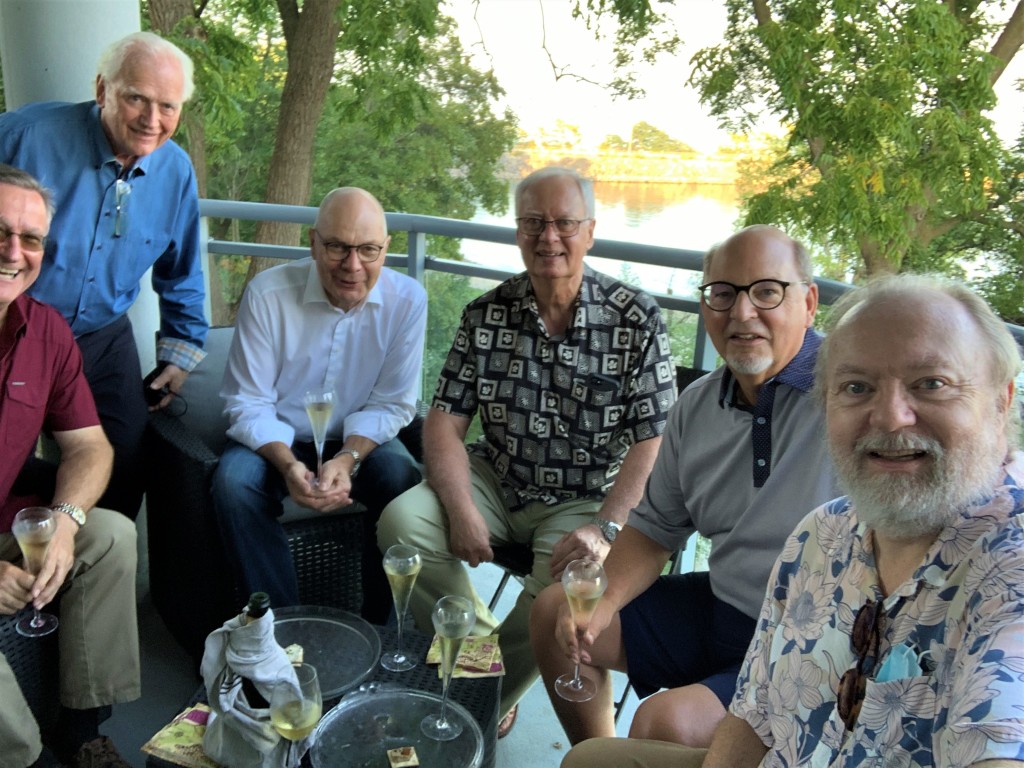
(L to R) Warren Walker, moi, David Larone, David Moorcroft, Philippe Gadbois and Jamie Winterhalt
Now then, to the tasting. It was to be in the style of the old Montreal events, without the $20 charge. It would be simple fare to support the wines; no stinky cheese or pungent horseradish sauce to destroy the olfactory senses. The wines would still be served blind to test the lads’ vinous acumen but I added a new wrinkle. After completing each bottle and musing thereupon, I would recite some authority’s comments about the wine and we would then compare notes. I thought this might be fun for the first few wines but had no illusions that focus could be maintained as the evening progressed. The first two bottles to make the ultimate sacrifice were uncorked out on our balcony with resounding pops. They were accompanied by a tray of toasts slathered in a tuna and Boursin cheese spread and another of toasts adorned with foie gras mousse with a dollop of pear and cognac chutney on top. At this point I should fess up and declare that my wife Hélène looked after all of the evening’s sustenance.
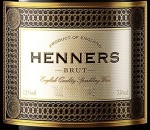
The initial bottle of fizz was variously identified as a decent but not stellar Champagne, likely not vintage. David Larone said he had never tasted another effervescent wine like it. Well, he was right for it was non-vintage Henners Brut from England. Here’s how the LCBO described it: “This English bubbly was produced solely from grapes grown on the winery’s estate. It’s bursting with crisp apple, juicy citrus and rich, toasty brioche notes on the way to a long, luxurious finish. Plenty of quality here.” Crisp apple and citrus maybe, but no one detected the toasty brioche. It cost about the same as a decent grower’s Champagne but in our considered opinion not a patch on it. In fact, I think the KEW Vinyards Tradition at half the price is a much better buy.
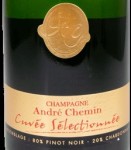
The second bottle of bubbly presented absolutely no challenge to the lads. They nailed it as a very good non-vintage Champagne – it was the André Chemin Cuvée Sélectionée Brut 1er Cru Champagne. Decanter Magazine had this to say: “80% Pinot Noir; 20% Chardonnay Decanter Gold, 2020 World Wine Awards. An educated nose of honeycomb, verbena, Alpine strawberry and a touch of spice. The palate is rich and rounded with notes of red berries and summer flowers; poised and persuasive. Masterful Champagne. Score – 95.” These notes totally lost us at “an educated nose of honeycomb.” And, who among us had ever tasted “an Alpine strawberry”? In fact, we felt that the Henners description was closer to the mark. This beauty cost a little more than the Henners and worth every additional penny.

We then moved inside to our dining room table where all the fixings for a smoked salmon plate awaited along with glasses of a light straw-coloured white wine. This was quickly identified as a Burgundy but that is about as far as it got. It was a Domaine Bachelet-Ramonet Père et Fils 2018 Chassagne-Montrachet 1er Cru La Grande Montagne. I selected this wine in tribute to our missing member Hugh Oddie (whom we toasted) who enjoys a bottle of Chassagne-Montrachet whilst he opens his gifts each Christmas morning. Here’s the LCBO’s verbiage: “La Grande Montagne is situated in the most southerly reaches of Chassagne-Montrachet’s limestone hills. This wine is aged between 14 and 16 months and offers the area’s classic power and elegance, with apple, lemon citrus and a touch of saline minerality. This succulent, well-defined wine will be superb with seafood dishes.” We agreed that was pretty close but rejected the “saline minerality” and added peach notes and a buttery finish. We really enjoyed it.
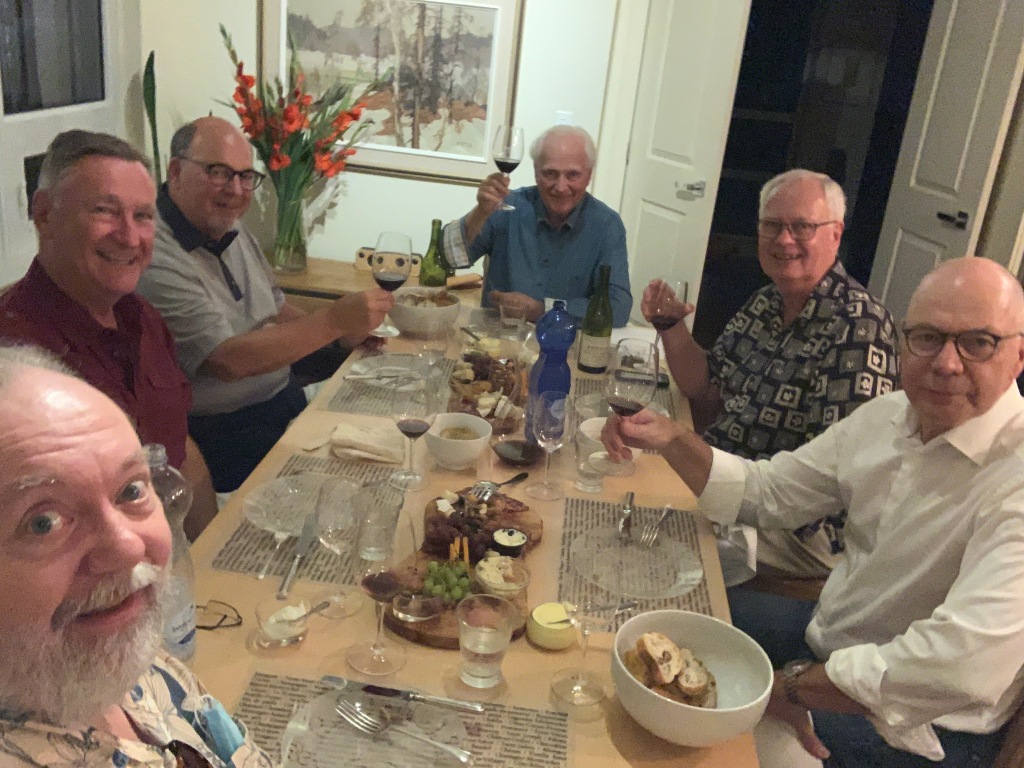
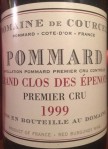
We exchanged the scant remnants of the smoked salmon for a couple of fully loaded charcuterie boards and brought on the first of the reds. It turned out to be one of the night’s favourites. Like the white that preceded it, our tasting team correctly identified it as a Burgundy but bogged down at that point. It was a Domaine Courcel 1999 Pommard 1er Cru Grand Clos des Epenots. Verve Wines offered this rather meagre description: “…the 1999 vintage is lively and structured, showing flavors of red fruit, herbs, black pepper, and earth. Tannins will continue to integrate gorgeously over the next few years.” Everything had integrated gorgeously for it was a simply splendid Burgundy.

The second red was presented and the panel thrashed around for a while before coming to the conclusion that it was from southern France – a Châteauneuf du Pape or a Gigondas. Right once again! It was a 1998 Château La Nerthe Cuvée des Cadettes Châteauneuf du Pape. This is what the noted wine critic Robert M. Parker, Jr. said about it in his Wine Advocate magazine: “Possibly the greatest vintage ever for this cuvee (we’ll see if the 2010 tops it in another decade), the 1998 Châteauneuf du Pape Cuvee des Cadettes is up with the crème de la crème of the vintage. Still fresh, concentrated and lively, with medium to full-bodied richness and polished tannin, it reveals a vibrant ruby color to go with tons of garrigue, leather, chocolate, cured meats and spice. It’s an incredible, modern-styled Châteauneuf du Pape that’s drinking spectacularly today. (8/2015) 96 points.” You must understand that by this point we were in no condition to quibble over Mr. Parker’s salient comments. I adored this wine.

The third red was poured and nobody came remotely close to identifying it. Was it because of the wine we were tasting or the wine we had tasted? It was a Penfolds 1981 Grange Hermitage that had been recorked at the Penfolds’ Toronto recorking clinic. Here’s how Penfolds wrote it up in The Rewards of Patience – Fifth Edition (2004): “Deep crimson brick red. Liquorice/dried fig/baked red fruit aromas. A powerfully concentrated and muscular wine with chocolate/raisin fruit, earthy nuances and a touch of American oak. The tannins are soupy and dense and build up very chalky and dry at the finish. Will it ever soften out? 89% Shiraz, 11% Cabernet Sauvignon. Drinking Window: Now – 2025.” It was but 12.7% alcohol by volume. Who is going to argue with the winery? It had indeed softened out but had lost some of its power. After 40 years, no wonder. But what a treat.
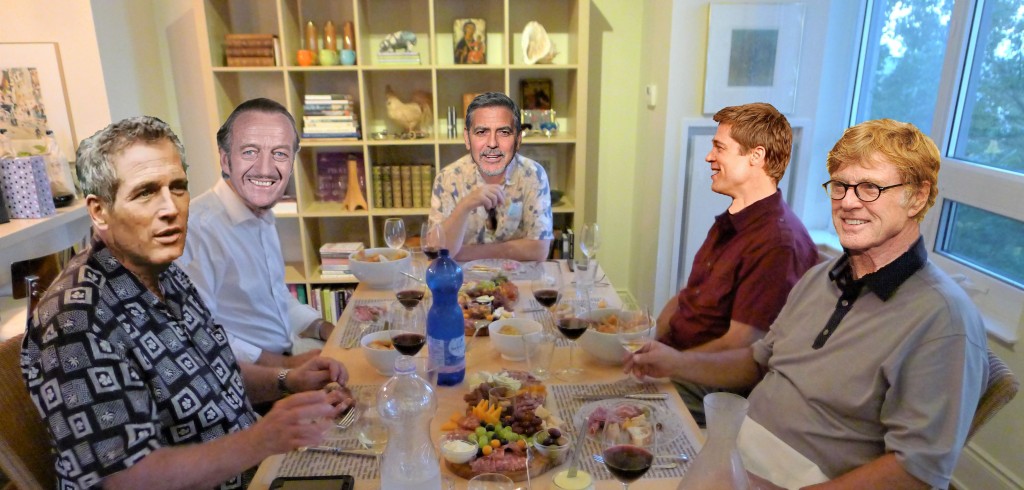

For some daft reason I had included a fourth red. I wished I hadn’t. A couple of the now somewhat tipsy topers declared it to be quite quaffable while the rest declared it to be definitely not up to snuff. No one had a clue about what it was except it was red. In fact it was an Il Poggione 1995 Brunello di Montalcino. The American wine critic Antonio Galloni had this to say: “Il Poggione’s 1995 Brunello di Montalcino Riserva is an awesome, vibrant wine loaded with dark cherries, smoke and earthiness. Still quite fresh and structured, it is clearly a wine that requires patience. 94/Anticipated maturity: 2015-2025.” Perhaps, but Hugh Oddie would have declared it to be “a wretched Italian jobbie”.
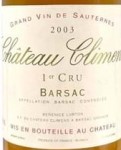
It was time for dessert – a strawberry cheesecake from The Cheesecake Factory. The amber coloured, unctuous sticky that accompanied it was, astonishingly, identified as a Sauternes. And, so it was, a 2003 Château Climens Barsac: “Loads of honey, maple syrup, dried apricot and spice. Full-bodied, medium-sweet, with a refined, spicy character. Pretty wine. Masses of botrytis. This is refined and long, a racy wine compared with the power and muscle of so many others. Beauty among the beasts. Best after 2012.96/100, James Suckling, WineSpectator.com, Mar 2006.” Our only salient observation was that no one tasted maple syrup. It was an absolutely gorgeous Sauternes.

Last but certainly not least was a dark, almost inky red wine that was deemed to be a port of indeterminate vintage. The gaggle of tasters was right once again. It was a Graham’s 1994 Vintage Port. Here’s Mr. Parker’s take: “In a port tasting, tasting Graham’s is almost like tasting a big, rich, succulent Merlot after a group of blockbuster, tannic Cabernets. Sweeter and more obvious than many ports, the opaque purple-colored 1994 is fruity, powerful, and rich, with an addictive hedonistic quality. It will be ready to drink in 8-10 years and keep for up to 30. As always, this is a showy, flamboyant port that has the advantage of being slightly sweeter than other 1994s. A great Graham’s. Anticipated maturity: 2002-2035. RP96.” I might add that it was 20 per cent alcohol by volume. Parker didn’t really describe it very well. Neither did our sagging sippers who really were in no condition to describe anything!
It was just about then that the Uber calls were made and the last tentative sips of the Graham’s were had. Another wonderful tasting event was over (except for the monumental clean-up which I managed to complete by noon the following day). I pitied the poor Uber drivers.
Cheers! Jim
PS: If you are interested in some really great wines from the Southern Rhône such as Côtes du Rhône, Vacqueyras, Gigondas and Châteauneuf du Pape, you might consider joining my Arthur’s Cellar Wine Club – no fees or other obligations, just marvellous wine.
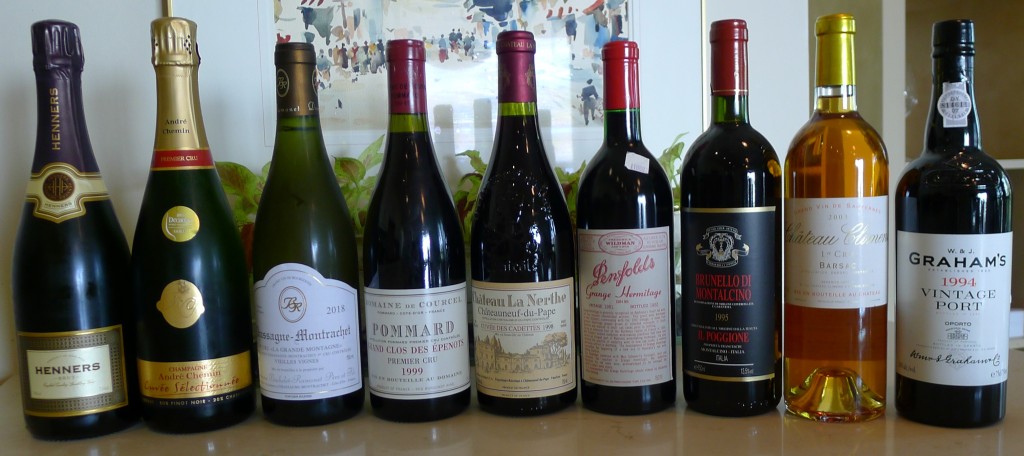
This is Jim’s 66th post on Gentleman’s Portion. Please LIKE this blog, if you have enjoyed the article, or add a COMMENT — clickable at the top of each story. Click on the FOLLOW button at the bottom of the page if you would like to receive email notifications of new articles. The SEARCH function at the top works really well if you want to look back and see some of his previous stories.
Categories: Wine

I’m feeling a bit David Niven-ish myself after reading about all this imbibing of splendid wines!
LikeLike
A lovely trip down memory lane and a trot into modern times.
LikeLike
Jim, are you saying I don’t look like Paul Newman when I’m sober?!
LikeLike
More like George Peppard, David, more like George Peppard … but the sightings are rare!
LikeLike